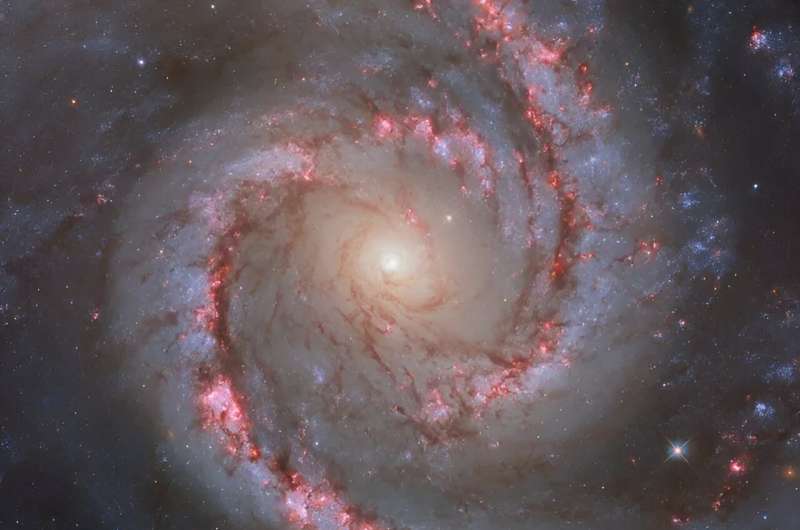This article has been reviewed according to Science X's editorial process and policies. Editors have highlighted the following attributes while ensuring the content's credibility:
fact-checked
proofread
Image: Hubble captures spiral galaxy NGC 1566

This vibrant Hubble Space Telescope image features the spiral galaxy NGC 1566, sometimes informally referred to as the "Spanish Dancer Galaxy." Like the subject of another recent image, NGC 1566 is a weakly-barred or intermediate spiral galaxy. This means that it does not have a clearly present or a clearly absent bar-shaped structure at its center.
The galaxy owes its nickname to the vivid and dramatic swirling lines of its spiral arms, which could evoke the shapes and colors of a dancer's moving form. NGC 1566 lies around 60 million light-years from Earth in the constellation Dorado and is a member of the Dorado galaxy group.
A galaxy group is a collection of gravitationally bound galaxies. They differ from galaxy clusters in size and mass: galaxy clusters may hold hundreds of galaxies, while galaxy groups might only hold several tens of galaxies. However, groups are the most common collection of galaxies in the universe, holding more than 50% of all galaxies. Although there is currently no precise number delineation between the definition of a galaxy group and a galaxy cluster, some astronomers have suggested that collections with less than 80 trillion Suns should be classified as galaxy groups.
The Dorado group membership has fluctuated over the past few decades, as various scientific papers changed its list of constituent galaxies. This is one example of why it is so challenging for astronomers to pin down members of galaxy groups like the Dorado group.
One way to better understand this problem is by imagining a photograph of an adult human and a large oak tree. We know the approximate size of the person and the tree, so if we see a photo where the person appears roughly the same size as the tree, then we would assume that, in reality, the person was much closer to the camera than the tree.
When astronomers try to figure out which galaxies are members of a galaxy group, they do not necessarily know the size of the individual galaxies. Instead, they have to work out whether the galaxies really are relatively close together in space, or whether some of them are actually much closer or much further away. This process is easier with more sophisticated observation techniques, but it still can present a challenge.
Provided by NASA



















